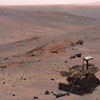

Spirit and Opportunity are still surveying the Martian surface, over 1100 sols (Martian days) after their initial 90 day mission was officially completed. Both Rovers are still collecting sample data and photographs of the red planet with no end in sight for the extended mission.
Spirit landed on Mars on 3 January 2004 with Opportunity landing only three weeks later on the opposite side of the planet. This initial mission was set to last just 90 days. June marks over one 1100 days since the end of that first mission - when the Rovers were expected to expire.
The two mobile robots, running on Wind River's mission-critical VxWorks realtime operating system (RTOS), have roamed Mars in search of signs that it once supported liquid water on the surface. Indicators of water on the Martian surface would mean that it may have once supported life. Any water found could also be used to manufacture rocket fuel on Mars.
The Rovers have now endured two harsh Martian winters, when lack of sunlight forces both machines into a hibernation phase. The mission has now been extended four times because of the indomitable resilience of the two robots. This has allowed the Rovers to delve much deeper into the history of the Martian landscape and environment than engineers had originally planned.
Spirit and Opportunity have identical suites of five scientific instruments: a panoramic camera and a microscopic imager provided by NASA's Jet Propulsion Laboratories; a miniature thermal emission spectrometer from Arizona State University; an alpha particle X-ray spectrometer from Max Planck Institute for Chemistry and a Moessbauer spectrometer from the Johannes Gutenberg University in Germany.
These are augmented by a rock abrasion tool for removing the weathered surfaces of rocks to expose fresh interiors for examination. The payload also includes magnetic targets provided by the Niels Bohr Institute in Denmark to catch samples of Martian dust for examination. The spectrometers, microscopic imager and abrasion tool share a turret at the end of a robotic arm.
The series of Mars Rover missions has not been completely problem-free. Spirit has driven 7 kilometres on the Martian surface, 11 times the goal set as part of a successful initial mission. At one point one of its six wheels had developed a malfunction. However, controllers were able to drive Spirit with only five fully-functioning wheels.
Mike Deliman, Wind River's engineering specialist on the Mars Rover project, explains: "Mission critical systems need to be flexible to accommodate any hardware that has to run off the device and continue to work under changing conditions. It is robust enough that Spirit continues to function with only five wheels - long after its initial mission was completed."
For more information contact Andrew Palmer, Embedded Industrial Solutions, +27 (0)12 547 6071, [email protected], www.eisol.co.za
| Email: | [email protected] |
| www: | www.eisol.co.za |
| Articles: | More information and articles about Embedded Industrial Solutions |

© Technews Publishing (Pty) Ltd | All Rights Reserved